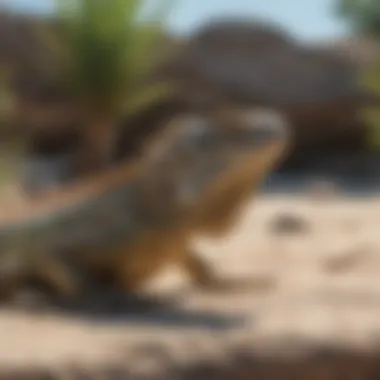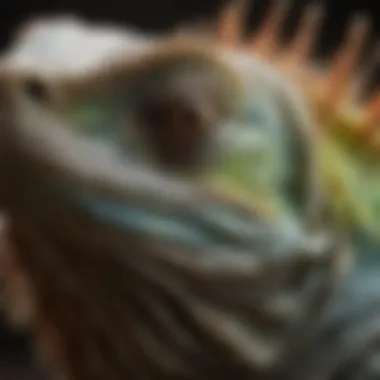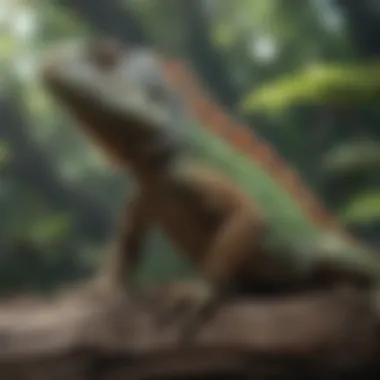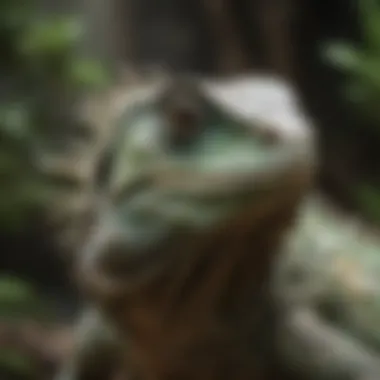Unveiling the Intriguing World of Iguanas: Exploring Fascinating Facts


Animal Species Profile
Embark on an enthralling journey into the world of iguanas, a species of unique reptiles that captivate the minds of many enthusiasts. These fascinating creatures, known for their distinctive appearance and behavior, offer a glimpse into the wonders of the animal kingdom. Let's delve into the intricate details that define iguanas and make them truly remarkable.
Introduction to the Animal Species
Iguanas, belonging to the family Iguanidae, are herbivorous reptiles characterized by their long tails, sharp claws, and rows of spines along their backs. With a wide diversity of species found across various regions, including Central and South America, the Caribbean, and Pacific Islands, iguanas showcase remarkable adaptations to thrive in diverse habitats.
Physical Characteristics and Appearance
Iguanas are recognized for their scaly bodies, which can range in color from vibrant green to dull shades of brown and grey, aiding in camouflage among their natural surroundings. Their elongated bodies, supported by strong, clawed limbs, enable agile movement and adept climbing skills, essential for foraging and escaping predators.
Natural Habitat and Distribution
In the wild, iguanas inhabit a range of environments, from lush rainforests to arid deserts, displaying their remarkable adaptability. These reptiles are often found basking in the sun atop rocky outcrops or tree branches, regulating their body temperature. The distribution of iguanas spans from North to South America, showcasing the species' widespread presence.
Behavior and Social Interactions
Iguanas exhibit intriguing behaviors that reflect their social dynamics and survival instincts. From territorial displays, such as head bobbing and tail flicking, to communal nesting sites, iguanas display complex social structures. Understanding their behaviors provides insights into their communication methods and hierarchical structures within colonies.
Introduction
Delving into the intriguing realm of iguanas unveils a tapestry of fascinating facts and wonders awaiting avid explorers of the reptilian world. In this article, we embark on a captivating journey through the nuanced intricacies of these unique creatures, shedding light on their evolutionary heritage, ecological significance, and intriguing behaviors. By immersing ourselves in the realm of iguanas, we gain a deeper appreciation for their role in the ecosystem and the marvels of their existence.
As we peel back the layers of the iguana's world, we encounter a mosaic of evolutionary adaptations, ranging from their ancient origins to their distinctive physiological features. By understanding the evolutionary background of iguanas, we gain insight into the mechanisms that have shaped their form and function over millennia. This section serves as a foundational pillar for unraveling the mysteries that define these remarkable reptiles.
Structured effectively to unfold a tapestry of scientific insights and ecological relevance, our exploration of iguanas' habitat and distribution unveils a landscape rich in diversity and complexity. By delving into their natural habitats and global distribution patterns, we illuminate the interconnected web of ecosystems that support the existence of these captivating creatures. Through a lens of exploration and inquiry, we uncover the myriad ways in which iguanas interact with and adapt to their environmental surroundings, enriching our understanding of their ecological significance.
Embarking on a detailed examination of the physiological features of iguanas, we uncover a realm of skin adaptations and tail functionalities that underscore the resilience and adaptability of these reptiles. From their intricate skin patterns that facilitate thermoregulation to the multifaceted roles of their tails in locomotion and communication, each facet of their physiology unravels a chapter of evolutionary mastery honed through generations.


Diving into the behavioral patterns of iguanas, we navigate a labyrinth of feeding habits and social interactions that offer a window into the intricacies of their daily existence. By observing their feeding rituals and examining their social dynamics, we gain insight into the behavioral complexities that shape their interactions with the environment and each other. Through a lens of curiosity and discovery, we unravel the threads of behavior that weave the fabric of iguana society.
Exploring the realm of reproduction and life cycles, we delve into the realms of courtship rituals and egg incubation, illuminating the stages of the iguana's life journey with precision and insight. By examining the intricate rituals of courtship and the delicate process of egg incubation, we gain a deeper appreciation for the complexity and beauty of iguana reproduction. This section serves as a testament to the intrinsic ties between life, survival, and perpetuation within the world of iguanas.
Navigating through the intriguing intersections of iguanas in popular culture, we unravel the threads that weave these reptilian wonders into the tapestry of human fascination and admiration. By exploring their depictions in art, literature, and media, we unveil the enduring impact and symbolism that iguanas hold within the collective human imagination. Through a lens of cultural exploration and discovery, we celebrate the enduring legacy of iguanas in popular consciousness.
Surveying the landscape of conservation efforts for iguanas, we scrutinize the threats to their survival and initiatives aimed at protecting these unique creatures. By identifying the challenges that jeopardize their existence and highlighting the measures taken to safeguard their habitats, we shed light on the urgent need for conservation action. This section serves as a call to arms, urging readers to join the collective effort in preserving the heritage and diversity of iguanas for generations to come.
Evolutionary Background of Iguanas
In delving into the realm of iguanas, comprehending their evolutionary journey becomes paramount to understanding these unique reptiles fully. The evolutionary background of iguanas serves as a portal into their intricate history, shedding light on the adaptations and developments that have shaped their existence over millennia. By dissecting this evolutionary chronicle, we unravel the genetic tapestry that distinguishes iguanas from other species, highlighting their resilience and ability to thrive in diverse environments. This section delves into the specific elements that have propelled iguanas through evolutionary epochs, showcasing their remarkable capacity to adapt and evolve with changing landscapes and climates.
Ancient Origins
The ancient origins of iguanas trace back to primordial eras, unveiling a narrative steeped in resilience and survival. These descendants of prehistoric ancestors have honed their existence through millennia of natural selection, crafting a blueprint for survival that stands the test of time. By exploring the ancient origins of iguanas, we unravel the threads that bind them to their ancestral lineage, appreciating the genetic heritage that courses through their veins. This subsection delves into the primordial landscapes that iguanas once roamed, painting a vivid picture of their evolutionary odyssey amidst ancient flora and fauna.
Distinctive Characteristics
Central to the allure of iguanas are their distinctive characteristics, which set them apart as marvels of the reptilian world. From their prehensile tails to their iconic dewlaps, iguanas boast a myriad of features that captivate and intrigue observers. By examining these distinctive traits in detail, we uncover the ingenious adaptations that enable iguanas to thrive in their habitats. This section delves into the intricate anatomical nuances of iguanas, exploring how these features align with their behavioral patterns and evolutionary legacy.
Iguanas Habitat and Distribution
In this section, we delve into the essential topic of Iguanas' Habitat and Distribution, shedding light on crucial aspects that shape the living conditions and geographical spread of these fascinating reptiles. Understanding the intricacies of where iguanas thrive plays a pivotal role in appreciating their lifestyle and ecological significance. By examining their habitat preferences and global distribution patterns, we can unravel key insights into the adaptability and resilience of these incredible creatures.
Natural Habitats
Iguanas are predominantly found in diverse natural habitats, ranging from lush rainforests to arid deserts. These resilient creatures exhibit a remarkable ability to adapt to various environmental conditions, showcasing their versatility in surviving across different landscapes. Their natural habitats provide them with ample opportunities to display their distinctive behaviors and feeding habits, making each habitat type a crucial piece in the iguana's ecological puzzle.
Global Distribution
The global distribution of iguanas spans across continents, with varying species inhabiting distinct regions around the world. From the tropical regions of Central and South America to the arid landscapes of North America and the Caribbean islands, iguanas have established their presence across diverse climatic zones. Exploring the factors influencing their distribution sheds light on the evolutionary history and adaptive strategies that have allowed iguanas to thrive in a wide array of environments.


By delving into the nuances of iguanas' habitat preferences and global distribution, we gain a deeper appreciation for the intricate relationship between these reptiles and their surroundings. This section illuminates how environmental factors shape the survival and behavior of iguanas, highlighting the importance of conservation efforts aimed at preserving their natural habitats and ensuring their continued existence in the wild.
Physiological Features of Iguanas
Iguanas possess a fascinating array of physiological features that play a crucial role in their survival and adaptation to their environment. Understanding the physiological makeup of iguanas is instrumental in unraveling the intricacies of their biology and behavior. From skin adaptations to tail functionality, each aspect contributes significantly to the overall well-being of these remarkable reptiles.
Skin Adaptations
The skin of iguanas is a marvel of evolution, providing them with a shield against external threats and aiding in thermoregulation. Covered in protective scales, iguana skin not only guards them against predators but also helps in retaining moisture in arid environments. These scales are not just for protection; they also play a role in camouflage, blending seamlessly with their surroundings to avoid detection from potential threats. Additionally, iguana skin has the remarkable ability to shed periodically, enabling the reptiles to remove parasites and maintain optimal health.
Tail Functionality
The tail of an iguana serves various functions crucial to its survival. Beyond being a tool for balance and coordination, the tail is a vital defense mechanism against predators. In times of danger, iguanas can use their tail to distract predators or even detach it, allowing them to make a swift escape while the predator is momentarily enthralled by the detached appendage. Furthermore, the tail plays a central role in regulating body temperature, acting as a heat sink in hot environments and assisting in thermal management. Through its multifaceted functionality, the tail of an iguana showcases the remarkable adaptability and resourcefulness of these enigmatic creatures.
Behavioral Patterns of Iguanas
The behavioral patterns of iguanas offer a window into their survival strategies, social dynamics, and even cognitive capabilities. By observing their actions related to feeding, social interactions, mating rituals, and territorial behaviors, researchers and enthusiasts can decipher a wealth of information about these enigmatic creatures. Understanding the intricacies of how iguanas navigate their surroundings and communicate with their counterparts provides valuable insights into their evolution and adaptation within their ecosystems.
Feeding Habits
When it comes to the feeding habits of iguanas, a fascinating world unfolds. These reptiles are predominantly herbivores, with a diet consisting mainly of leaves, flowers, fruits, and occasionally insects. Their specialized digestive system allows them to extract nutrients from fibrous plant materials efficiently. Observing how iguanas forage for food, select their prey, and process their meals offers a glimpse into their dietary preferences and adaptations.
Social Interactions
Another intriguing aspect of iguanas' lives is their social interactions. While often perceived as solitary creatures, iguanas do engage in certain social behaviors, especially during the breeding season. Males can exhibit territorial behaviors and compete for access to females, displaying complex courtship rituals. Understanding how iguanas communicate through visual displays, body language, and vocalizations sheds light on their social structure and reproductive strategies. Studying their social interactions provides valuable insights into the dynamics of iguana populations and the complexities of their social organization.
Reproduction and Life Cycle
In this section of the article, we delve into the intricate world of iguana reproduction and their life cycle, shedding light on essential aspects that underpin the survival and continuity of these fascinating reptiles. Understanding the reproductive behavior and life stages of iguanas is crucial for appreciating their evolutionary strategies and ecological role. By exploring the mating rituals and egg development of iguanas, we gain insights into their reproductive prowess and the challenges they face in ensuring the survival of their species amidst environmental pressures and human interventions.
Courtship Rituals


Courtship rituals in iguanas are a captivating display of behavioral patterns aimed at signal2ing readiness for mating and establishing dominance hierarchies among male counterparts. Through intricate dances, color displays, and territorial posturing, male iguanas vie for the attention of females in a high-stakes game of reproductive success. These rituals not only showcase the vigor and vitality of the male iguanas but also allow us to appreciate the complexity of communication and social dynamics in the wild.
Egg Incubation
The process of egg incubation is a critical phase in the reproductive cycle of iguanas, where the survival of offspring hinges on optimal environmental conditions and parental care. Female iguanas carefully select nesting sites and bury their eggs to protect them from predators and environmental fluctuations. By exploring the challenges of egg viability and the role of maternal instincts in fostering offspring survival, we gain a deeper appreciation for the resilience of iguanas in sustaining their populations in the face of adversity. Understanding the intricacies of egg development and hatchling emergence provides a glimpse into the delicate balance of nature and the remarkable adaptations that iguanas have evolved over time.
Iguanas in Popular Culture
Iguanas in popular culture hold a unique fascination, permeating various aspects of entertainment, folklore, and symbolism. These enigmatic reptiles have carved a niche in the creative world, appearing in films, artwork, and even as symbolic representations in different cultures. One can witness their presence in pop art, music album covers, and indigenous myths, adding a layer of mystique to their already intriguing existence. Artists often portray iguanas in surreal settings, blending reality with the fantastical, captivating audiences with their exotic allure.
The significance of iguanas in popular culture extends beyond mere representation; it serves as a mirror reflecting societal ideals, fears, and aspirations. Through art and storytelling, iguanas become metaphors for resilience, adaptation, and transformation. Their portrayal conveys a sense of freedom, wildness, and untamed beauty, capturing the imagination of viewers and readers alike. Moreover, in cultural narratives, iguanas often symbolize wisdom, regeneration, or even danger, evoking a range of emotions and interpretations.
Considering iguanas in popular culture within the context of this article adds a nuanced dimension to our understanding of these reptiles. By exploring how they are depicted in various creative mediums, we gain insights into the diverse perceptions people hold towards iguanas. From being exotic pets showcased in glamorous settings to mythical creatures embodying ancient folklore, the depiction of iguanas in popular culture unveils layers of symbolism and fascination. Understanding their cultural significance enriches our appreciation for these creatures and deepens our connection to the natural world.
Delving into the realm of iguanas in popular culture not only enriches our aesthetic sensibilities but also prompts critical reflections on human-animal relationships and conservation efforts. By contextualizing iguanas within the tapestry of pop culture, we acknowledge their impact on human creativity and storytelling. Whether adorning graffiti walls in urban landscapes or gracing the covers of graphic novels, iguanas captivate us with their enigmatic presence, sparking conversations about nature's marvels and our responsibility towards protecting biodiversity.
Conservation Efforts for Iguanas
To comprehend the essence of conservation efforts for iguanas, within the expansive realm of exploring fascinating facts about these captivating reptiles, one must appreciate the pivotal role such endeavors play in ensuring the continuity of iguana species. Conservation efforts are paramount given the numerous threats that loom over these creatures, stemming from human activities and environmental changes. By shedding light on conservation efforts, this article aims to highlight the urgent need for proactive measures to safeguard iguanas and preserve biodiversity. The significance of focusing on conservation efforts lies in safeguarding the delicate ecological balance and maintaining the irreplaceable beauty of these remarkable creatures.
Threats to Their Survival
In the intricate web of challenges facing iguanas, various threats perilously threaten their existence. Habitat destruction wrought by deforestation, urbanization, and industrialization poses a grave danger to these reptiles. Climate change further exacerbates the situation, leading to altered habitats and threatening the food sources vital for their survival. Illegal wildlife trade also remains a pressing concern, with iguanas often falling victim to this illicit activity. Understanding and addressing these threats is imperative to ensure the continued existence of these captivating creatures.
Initiatives to Protect Iguanas
In response to the dire need for conservation, a range of initiatives has been established to protect iguanas from the multitude of threats they face. Conservation projects focus on restoring and preserving iguana habitats, implementing stricter regulations against illegal trade, and raising awareness about the importance of these reptiles in the ecosystem. Collaborative efforts between governments, conservation organizations, and local communities play a crucial role in safeguarding iguanas. By supporting initiatives aimed at protecting iguanas, individuals can contribute to the preservation of biodiversity and the sustenance of these unique reptiles for future generations.
Conclusion
In this final section of our exploration into the fascinating facts about iguanas, it is imperative to reflect on the significance of this comprehensive discourse. The Conclusion serves as a crucial encapsulation of the key insights and revelations uncovered throughout the article, offering readers a synthesized understanding of the intricacies of the iguana's world.
One of the paramount elements to consider when delving into the Conclusion is the culmination of varied topics discussed. From the evolutionary background to the behavioral patterns, each section has shed light on a different facet of these enigmatic reptiles. Bringing these fragments together in the Conclusion allows for a holistic view of the iguanas' world, enabling readers to comprehend the interconnectedness of different aspects of their existence.
Furthermore, the Conclusion serves as a bridge between knowledge acquisition and application. By summarizing the essential details presented throughout the article, readers are not only educated on the captivating facts about iguanas but are also equipped to appreciate and engage with these reptiles in a more informed manner. Whether it is understanding the significance of iguanas in popular culture or the critical importance of conservation efforts, the Conclusion acts as a call to action, inspiring readers to participate in the preservation and appreciation of these remarkable creatures.
In essence, the Conclusion of this article on iguanas is not merely a concluding statement but a portal to a deeper understanding and engagement with these fascinating reptiles. It encapsulates the essence of our endeavor to unravel the mysteries of iguanas and encourages readers to embark on their journey of exploration and appreciation of the natural world.







